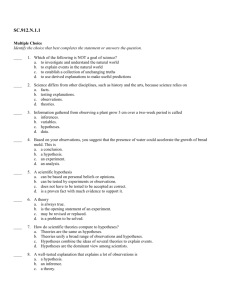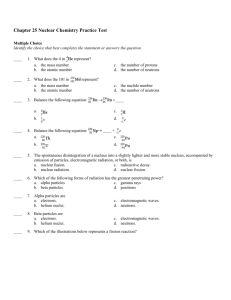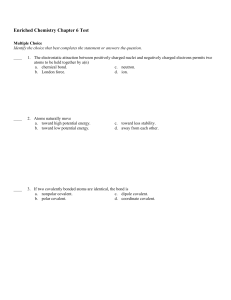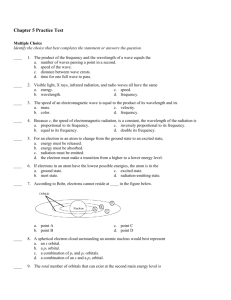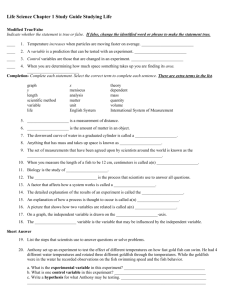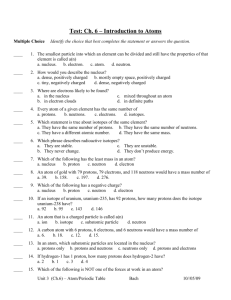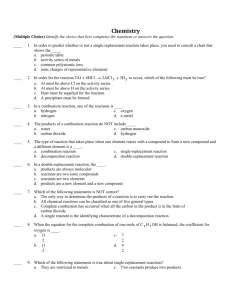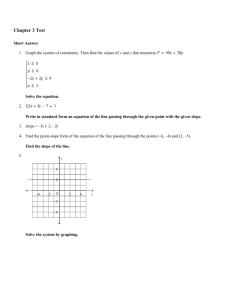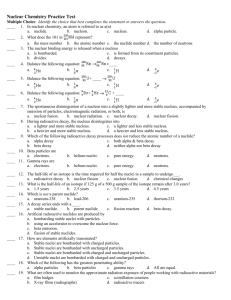Test Ch.4
advertisement
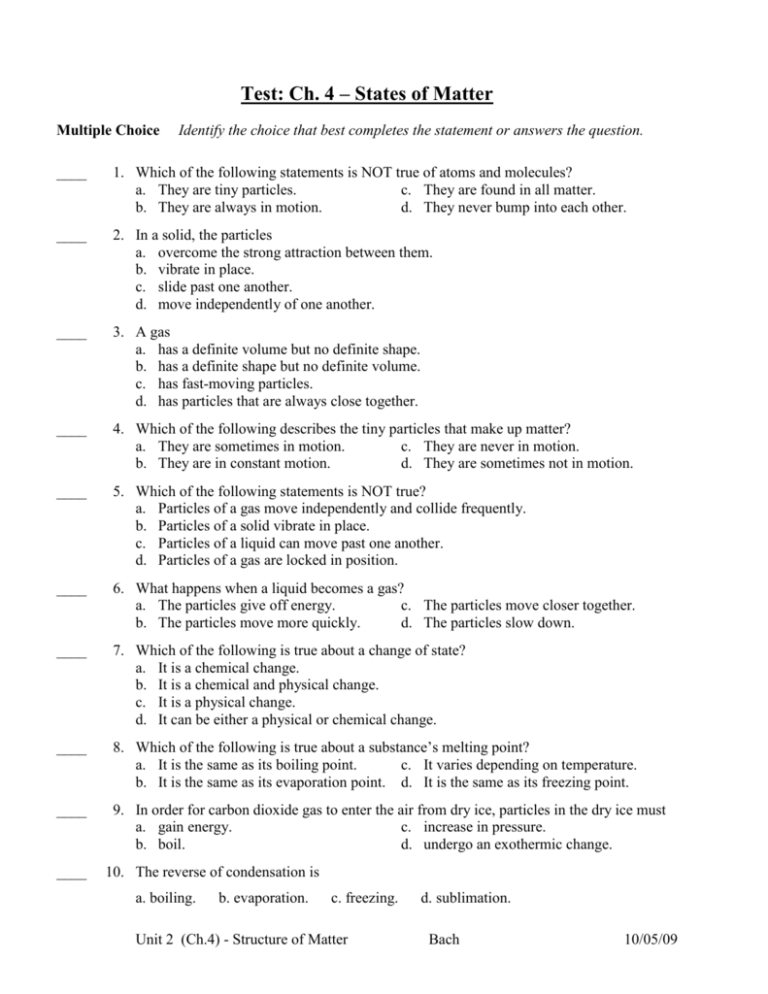
Test: Ch. 4 – States of Matter Multiple Choice Identify the choice that best completes the statement or answers the question. ____ 1. Which of the following statements is NOT true of atoms and molecules? a. They are tiny particles. c. They are found in all matter. b. They are always in motion. d. They never bump into each other. ____ 2. In a solid, the particles a. overcome the strong attraction between them. b. vibrate in place. c. slide past one another. d. move independently of one another. ____ 3. A gas a. has a definite volume but no definite shape. b. has a definite shape but no definite volume. c. has fast-moving particles. d. has particles that are always close together. ____ 4. Which of the following describes the tiny particles that make up matter? a. They are sometimes in motion. c. They are never in motion. b. They are in constant motion. d. They are sometimes not in motion. ____ 5. Which of the following statements is NOT true? a. Particles of a gas move independently and collide frequently. b. Particles of a solid vibrate in place. c. Particles of a liquid can move past one another. d. Particles of a gas are locked in position. ____ 6. What happens when a liquid becomes a gas? a. The particles give off energy. c. The particles move closer together. b. The particles move more quickly. d. The particles slow down. ____ 7. Which of the following is true about a change of state? a. It is a chemical change. b. It is a chemical and physical change. c. It is a physical change. d. It can be either a physical or chemical change. ____ 8. Which of the following is true about a substance’s melting point? a. It is the same as its boiling point. c. It varies depending on temperature. b. It is the same as its evaporation point. d. It is the same as its freezing point. ____ 9. In order for carbon dioxide gas to enter the air from dry ice, particles in the dry ice must a. gain energy. c. increase in pressure. b. boil. d. undergo an exothermic change. ____ 10. The reverse of condensation is a. boiling. b. evaporation. c. freezing. Unit 2 (Ch.4) - Structure of Matter d. sublimation. Bach 10/05/09 ____ 11. Solid dry ice changes to carbon dioxide gas through what change of state? a. melting b. evaporation c. freezing d. sublimation Use the figure to answer questions 12 through 15. ____ 12. Which of the changes of state shown in the figure require an increase in energy? a. freezing and evaporation c. evaporation and melting b. freezing and condensation d. condensation and melting ____ 13. Which of the changes of state shown in the figure require a decrease in energy? a. freezing and evaporation c. evaporation and condensation b. condensation and freezing d. melting and evaporation ____ 14. Boiling water is an example of which of the changes of state shown in the figure? a. freezing b. condensation c. evaporation d. melting ____ 15. Which of the following is NOT true of the changes of state shown in the figure? a. The melting point and freezing point are the same for a given substance. b. The temperatures at which condensation and evaporation occur are the same for a given substance. c. A solid cannot change to a gas through any of the changes of state shown. d. A solid can change directly to a gas through evaporation. ____ 16. Liquids tend to maintain a constant a. volume. b. pressure. c. surface tension. ____ d. viscosity. 17. Which of the following occurs when a gas becomes a liquid? a. The particles create energy. b. The particles break away from one another. c. The particles clump together. d. The particles stop moving. Unit 2 (Ch.4) - Structure of Matter Bach 10/05/09 Grading Scale (2 pt.s ea. – 2 extra credit Q’s – 30 pt.s possible) A = 34 – 27 B = 26 – 24 C = 23 – 21 D = 20 – 18 F < 17 Test: Ch.4 Answer Section 1. ANS: OBJ: MSC: 2. ANS: OBJ: 3. ANS: OBJ: 4. ANS: OBJ: MSC: 5. ANS: OBJ: MSC: 6. ANS: OBJ: MSC: 7. ANS: OBJ: MSC: 8. ANS: OBJ: 9. ANS: OBJ: 10. ANS: OBJ: MSC: 11. ANS: OBJ: 12. ANS: OBJ: MSC: 13. ANS: OBJ: MSC: 14. ANS: OBJ: D 1 SQ.1.1 B 2 C 3 B 1 CTA.0.1 D 2 CTA.0.2 B 2 CTA.0.3 C 1 CTA.0.4 D 3 A 2 B 2 CTB.0.9 D 2 C 2 CTB.0.17 B 2 CTB.0.18 C 2 PTS: 1 STA: 8.3.d | 8.3.e DIF: 1 REF: 1 KEY: atom | molecule PTS: STA: PTS: STA: PTS: STA: DIF: KEY: DIF: KEY: DIF: KEY: 1 8.3.e 1 8.3.e 1 8.3.d 1 REF: solid MSC: 1 REF: gas MSC: 1 REF: atom | molecule 1 SQ.1.2 1 SQ.1.3 1 PTS: 1 STA: 8.3.e DIF: 1 REF: 1 KEY: solid | liquid | gas PTS: 1 STA: 8.5.d DIF: 1 REF: 2 KEY: change of state PTS: 1 STA: 8.3.e | 8.5.d DIF: 1 REF: 2 KEY: change of state PTS: STA: PTS: STA: PTS: STA: 1 8.7.c 1 8.3.e 1 8.3.d DIF: KEY: DIF: KEY: DIF: KEY: 1 REF: 2 melting MSC: CTA.0.7 1 REF: 2 sublimation MSC: CTB.0.6 1 REF: 2 condensation | evaporation PTS: STA: PTS: STA: 1 8.3.e 1 8.3.d | 8.5.d DIF: KEY: DIF: KEY: 1 REF: 2 sublimation MSC: CTB.0.10 1 REF: 2 melting | evaporation PTS: 1 STA: 8.3.d | 8.5.d DIF: 1 REF: 2 KEY: condensation | freezing PTS: 1 STA: 8.5.d DIF: 1 REF: 2 KEY: boiling | evaporation Unit 2 (Ch.4) - Structure of Matter Bach 10/05/09 MSC: 15. ANS: OBJ: 16. ANS: OBJ: 17. ANS: OBJ: MSC: CTB.0.19 D 3 A 3 C 2 CTC.0.12 PTS: STA: PTS: STA: PTS: STA: 1 8.5.d 1 8.3.e 1 8.3.e Unit 2 (Ch.4) - Structure of Matter DIF: KEY: DIF: KEY: DIF: KEY: 1 evaporation 1 liquid 1 condensation Bach REF: MSC: REF: MSC: REF: 2 CTB.0.20 1 CTC.0.11 2 10/05/09
